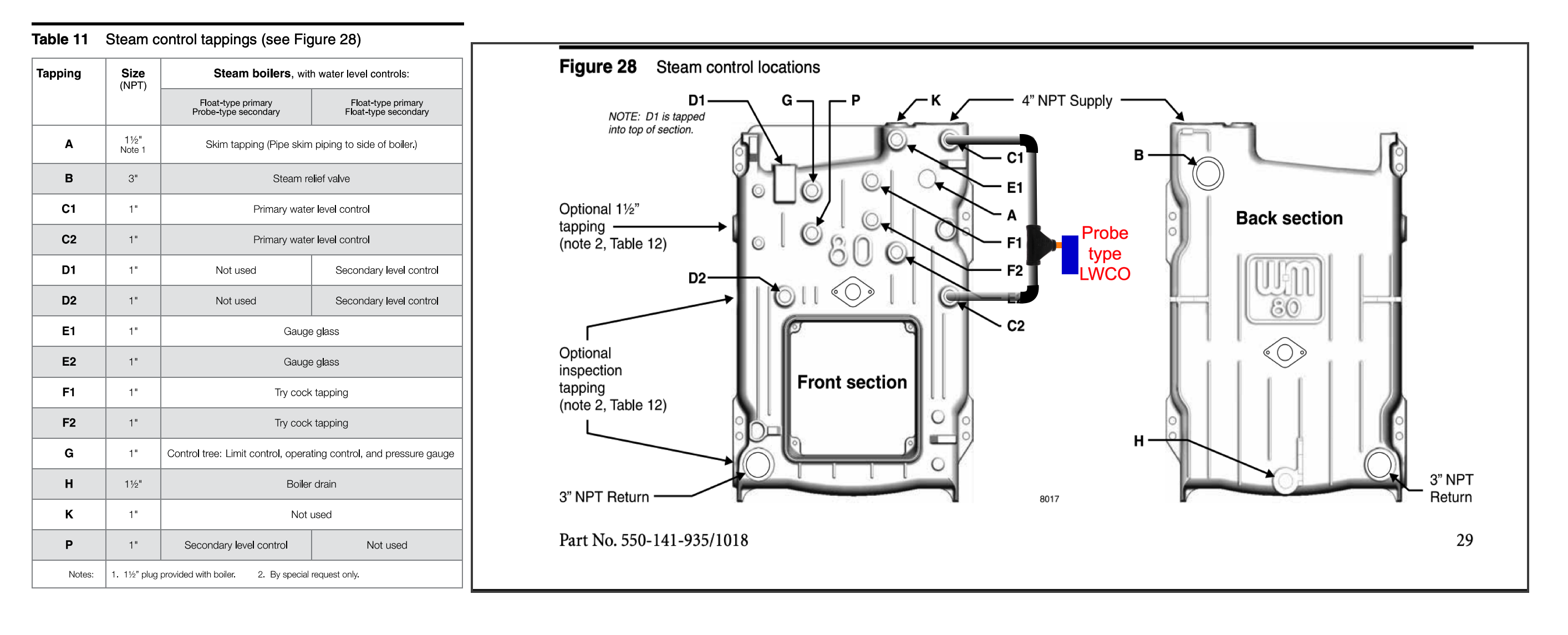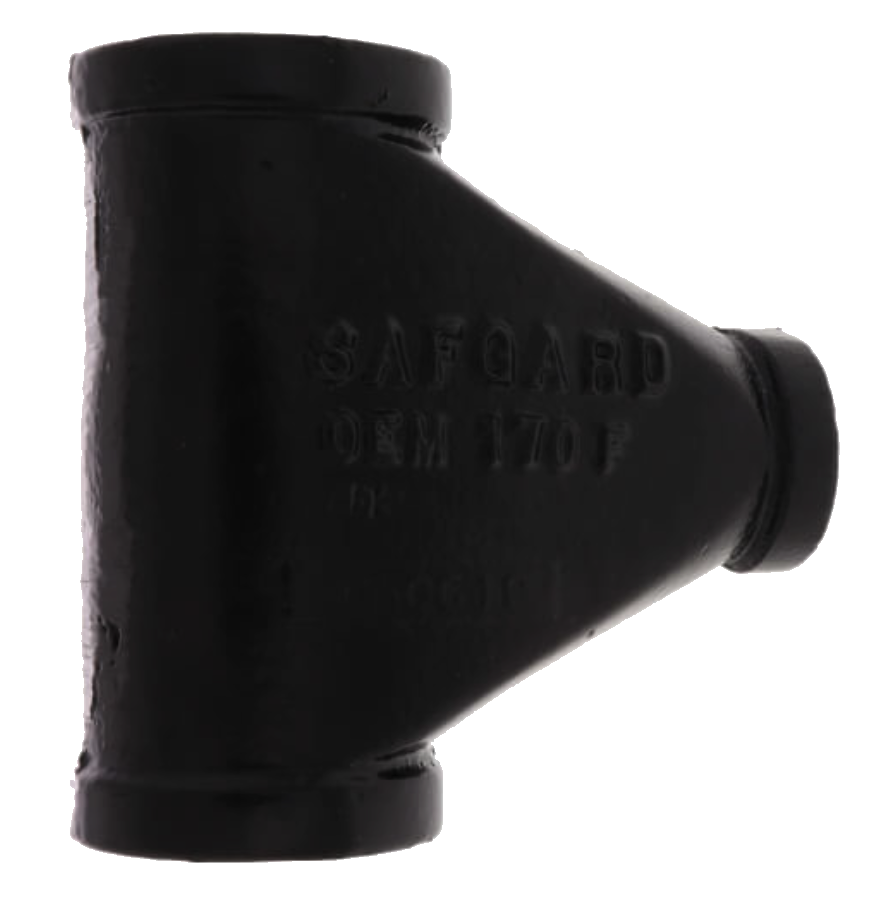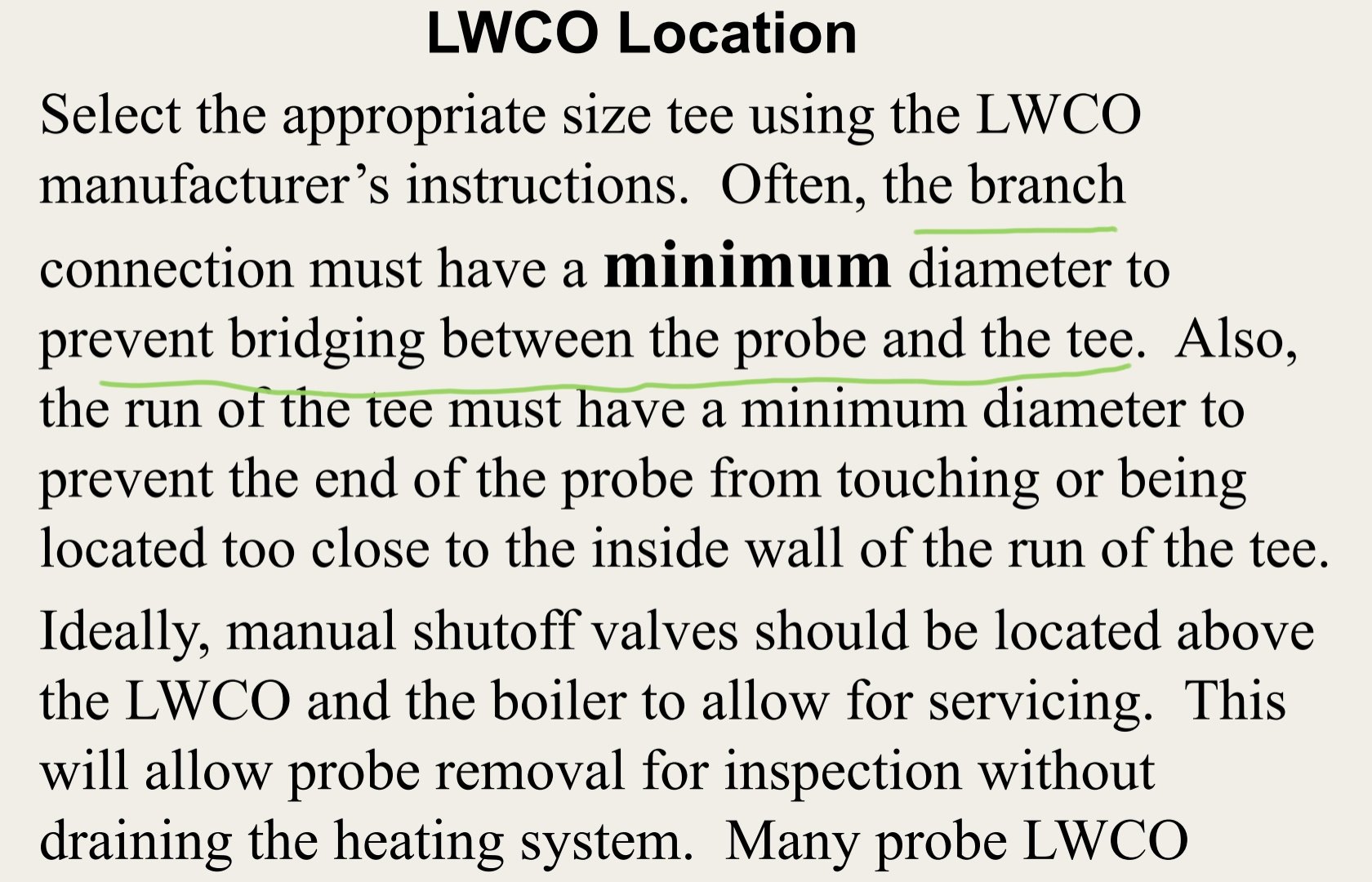Best Of
Re: Burnham boiler question
Varies from boiler to boiler. Anywhere between 1/3 and 2/3 is typically acceptable. Ideally, 1/2 to 2/3, is more efficient.
Re: Burnham boiler question
YOU HAVE A STEAM BOILER!!!!
The information you are referring to is instructions for a water boiler. A water boiler has water filled all the way up to the top radiator on the top floor of the building, and that water at the top is supposed to be under some pressure in order to purge all the air out of the system way up there. If you have lots of time on your hands you can learn more about water boilers. Knowledge you will never use where you are now. That knowledge will be helpful if you move to another home with a water boiler. In your situation I would not spend extra time learning about someone else's heating system. I would concentrate on your STEAM system.
Here is the illustration of a special tee fitting used in your previous query
On this commercial boiler you may be required to have as many as 3 LWCO depending on the application. The highest one to operate the water feed and a back up to stop the burner if the first one fails. The third one may be manual reset in the event that the first two fail for some reason. Other codes require only 2 LWCO. An operating LWCO with auto reset and a second one that is manual reset in the event that the operator LWCO fails.
If for some reason your boiler does not have the proper tapping you can place a side arm on other tappings to install a LWCO outside the boiler as shown in the illustration where I added pipes to C1 and C2 openings. Then place the LWCO Tee fitting at the proper level for your application.
That special Tee is what the instructions were referring to when a normal Tee may form a bridge.
I hope this info helps you better understand that there are more uses for that LWCO than just your boiler. There are many other applications that the LWCO you have can be used for.
Re: Wood boiler thermostatic mixing valve help
12- 15 psi is adequate. If you raise fill pressure the expansion tank pre-charge pressure should be adjusted also.
Tanks are usually shipped with a 12 psi charge, but it is always wise to check that.
Loosen the lock nut and CCW on the slotted bolt, to lower pressure.
These hybrid systems can get piping complex!
 hot_rod
hot_rod
Re: Replacing draft regulator or draft control on a residential fuel oil boiler
The oil furnace was Yukon out of Minnesota. They used Wayne and/or Beckett burners.
I did help some contractors on the Blue Flame burner. When the flame was blue the CO was high. They got recalled because of the poisonings they were causing. Setting them for zero smoke was useless in evaluating their safety or proper operation.
Thanks Bob. I don't look as stupid or reckless when you chime in.
Re: Replace missing radiator
The new radiator will need to be larger than the original to heat both the kitchen and the enclosed breezeway. A heat loss calculation would tell you what capacity you need. This also affects the size of the radiator runout pipe from the main.
 bburd
bburd
Re: Is a small water heater an acceptable solution for extra heat on a heat pump system?
Why not just look at another brand of water-to-water heat pump? I have a GeoStar single-stage (with a soft start) and with a 180 gallon buffer tank and an ODR it basically makes any type of inverter turn-down on output not necessary.
Re: Replacing draft regulator or draft control on a residential fuel oil boiler
Ed,
Thanks for the reply. I did mean it when I said you were brilliant on mechanical problems.
When someone is told to do something that is not necessary that would cost additional money I try to pitch in. I could talk for hours on how many manufacturers called me for help. Many factory reps told me to help their customers but don't tell their company they did.
I guess solving a problem that no one else could solve led to some different methods in the field that had never been tried could be considered experimentation. But if a combustion analyzer wasn't used then it was a no no.
I was told in the 80's when I first started to help or train techs, that oil didn't make much carbon monoxide, mostly smoke. The highest level of CO I measured was on oil equipment with no smoke. One the first condensing oil furnace was produced the manufacturer sent their field service man to my town to find out why my customers weren't having trouble like everyone else. He found out I wasn't following factory specs. Not because I wanted to but because that was the only way to get them to operate properly. They ended up redesigning the furnace based on my input but it was too late.
While I am still able, I think I am older than you Ed and probably more senile, I just want to help people to learn. As a few techs on here that have been to my training they know everything I have done and teach is real. It is unfortunate that they are too afraid to do things mechanically correct versus political correct. The people that make equipment are artists, but the people that make them run correctly are engineers - YOU!
Bob Harper and I are friends, and he is the smartest person I think I have ever met. I even taught him something he didn't know - I think?
Re: Aprilaire 865 experience with fan noise and air temp exhausting from fan?
You will hear it when you first get it but it will blend in as not noticeable background noise eventually.
I like to use a residential refrigerator for comparison
A residential refrigerator compressor is generally fairly quiet, especially in modern units.
Typical Noise Levels
- ~35–45 dBA → common for newer, well-insulated refrigerators
- ~45–50 dBA → older models or during brief start-up cycles
- Above 50 dBA → usually indicates an issue (wear, vibration, poor leveling, or a failing compressor)
And you don't even notice that the compressor turns on and off regularly, in most cases.
As far as the temperature, it will be higher than the older Aprilaire 300 you are replacing. Steam is 212° F and when mixed with the ambient air will exit the fan warmer than the entering air. The 300 depends on evaporation. Evaporation usually has a cooling effect on the entering air.
Hope this helps
Re: Aprilaire 865 experience with fan noise and air temp exhausting from fan?
side note, older fridges usually are loud not because they were designed that way but because the bushings have rotted away and the compressor is now sitting directly on the frame.
Re: Pumps at risk of flood damage.
The pump can't be raised because it needs a gravity flow between the tank outlet and the pump's inlet. I.E. water doesn't flow uphill.
We'd have to take a look at all that return line piping and the outlet height of the lowest steam trap on this system. If the outlet of the lowest trap is considerably above the return line, then the return lines could be raised, which would allow the condensate tank to be raised, and then the condensate pump too.






